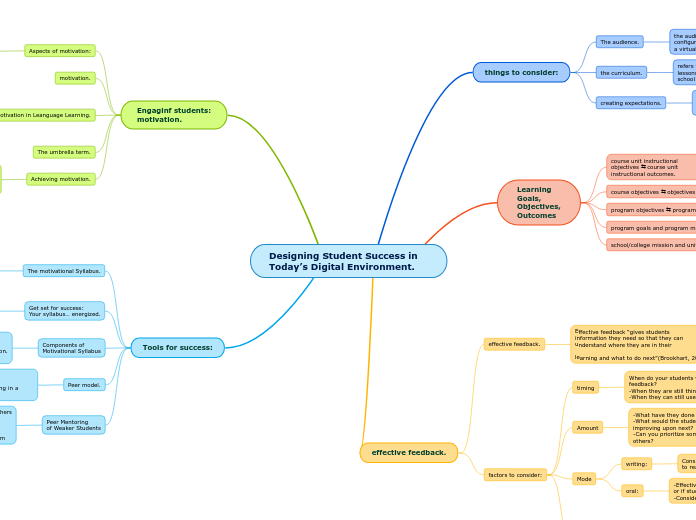Designing Student Success in Today’s Digital Environment.
things to consider:
The audience.
the audience is where we can have different configurations: work with childres, adults or in a virtual environment.
the curriculum.
refers to the
lessons and academic content taught in a
school or program.
creating expectations.
the teacher's approach must be set the expectations and offer tools for the students.
Learning
Goals,
Objectives,
Outcomes
course unit instructional objectives ⇆ course unit instructional outcomes.
course objectives ⇆ objectives outcomes
program objectives ⇆ program outcomes.
program goals and program missions.
school/college mission and university mission.
effective feedback.
effective feedback.
Effective feedback “gives students
information they need so that they can
understand where they are in their
learning and what to do next”(Brookhart, 2008).
factors to consider:
timing
When do your students want to get their
feedback?
-When they are still thinking about their assignment
-When they can still use it to make improvements
Amount
-What have they done well?
-What would the student benefit from
improving upon next?
-Can you prioritize some points over
others?
Mode
writing:
Consider amount student is willing and able
to read
oral:
-Effective when there is a lot to communicate
or if student does not read well
-Consider individual or group conferences
Audience.
individual.
Can specify for individual student (e.g. what
you know student can understand and act
upon)
group.
-Create a mini-lesson to teach point several
students are struggling with
-Use more experienced/proficient peers to
explain points to other students in group
Engaginf students:
motivation.
Aspects of motivation:
-Intrinsic factors
-Instrumental value
-Integrative value
-Extrinsic factors
motivation.
Motivation in Leanguage Learning.
-Language
-Content
-Teaching method
-Timing / Class management
-Discipline
-Administrative work
-And motivation
The umbrella term.
Achieving motivation.
Enthusiasm, commitment and
persistence are key factors in learning,
and are key determinants for success
or failure
Tools for success:
The motivational Syllabus.
How can we inspire confidence in
students that they can succeed?
We provide a roadmap for success:
information, tools, and resources to help
students to help themselves.
Get set for success:
Your syllabus… energized.
Research shows that strong course
design leads to positive outcomes such
as increased satisfaction, retention, and
achievement of learning outcomes.
Components of
Motivational Syllabus
-Course information.
-instructioon information.
-asignment and grading iformation.
-resources and support.
Peer model.
-Peers can be ideal role models for other students
-Allow peers to enforce class norms
-Invite past students to describe what they are doing in a higher grade level
Peer Mentoring
of Weaker Students
-Identify strengths of students and pair them with others
who need greater assistance. Students:
-Take on leadership role
-Become tutors and mentors
-Grow and improve their own skills by explaining them
